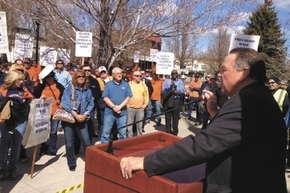Nevada AFL-CIO opposes proposed margins tax to fund public schools

CARSON CITY — The Nevada State AFL-CIO on Friday voted to oppose the margins tax measure to fund public education that is on the Nov. 4 general election ballot.
Also known as the Education Initiative, Question 3 would impose a 2 percent business “margins tax” designed to raise an estimated $700 million a year for public schools.
The measure is opposed by many Nevada businesses and elected officials, including Gov. Brian Sandoval. It was put on the ballot by the Nevada State Education Association, which represents teachers.
In a statement after a vote of delegates at a convention for the group’s Committee on Political Action, Danny Thompson, executive secretary treasurer, said: “The Nevada State AFL-CIO has always supported funding education to the National Average. There is no equivocation on our support for funding our schools so that our children receive a great education. We are a strong voice and advocate at every level of government for more funding for classrooms, teachers, and school buildings.
“The vote today in opposition to the margins tax initiative is not a vote against education,” he said. “It is a vote against a flawed initiative that will cost many of our members their jobs and raise the cost of living on Nevadans on a fixed income and on citizens that are still struggling to make ends meet after years of a terrible recession.”
Thompson said the group is committed to working with the state Legislature to reform the state’s tax system “so that education, mental health, infrastructure and local government can all be funded appropriately.”
The AFL-CIO originally backed the measure but began reconsidering its position after a study by the Las Vegas firm Applied Analysis suggested it would harm Nevada’s economy.
Thompson said in a phone interview there is an opportunity for the AFL-CIO to reconsider its position in August but that a second debate is unlikely.
A statement from Sandoval’s office said: “The governor respects the decision of the AFL-CIO, and this vote is further evidence that there is widespread opposition to this ill advised tax.”
NSEA President Ruben Murillo Jr. said the vote was a setback, but not the end of the effort to increase funding for public education.
“We still have a war to fight to fund education in Nevada,” he said.
With 150,000 people signing the petition to put the proposal on the ballot, and thousands of parents with children in the public schools who have said that more funding is needed, there is strong support for the measure, Murillo said. Other unions support it as well, he added.
The association will be happy to meet with the AFL-CIO between now and August to explain how the measure is an investment in the economy and not a job killer, he said.
Andy Matthews, president of the conservative think tank Nevada Policy Research Institute, said the AFL-CIO resolution notes how the margins tax would impose a large new tax burden even on businesses that are losing money, including construction companies.
“We welcome the AFL-CIO’s support in helping the public understand that taxes — taking money out of the private sector — have destructive effects for individual families and the economy as a whole,” he said. “The margin tax would cause many companies, especially construction companies that have been losing money for years, to close entirely.”
Thompson said the vote to oppose the ballot measure was well in excess of the two-thirds required to pass the resolution, but he would not pronounce the tax measure dead as a result, even with the AFL-CIO representing 200,000 workers in Nevada.
“I would not predict that,” he said. “I know people want a solution to funding for education because it is atrocious at best. We need to look at our tax system from A to Z.”
But there was a concern that the tax could harm Nevada’s economy and make it even tougher for businesses to survive, Thompson said.
A particular concern of the union was that subcontractors in the building trades would not have the ability to pass on the cost of the tax.
“General contractors can pass the cost on to the subcontractors, but they don’t have the ability to pass it on,” Thompson said. “Many are mom and pop operations that are just hanging on by a shoestring.”
Contact Capital Bureau reporter Sean Whaley at swhaley@reviewjournal.com or 775-687-3900. Find him on Twitter: @seanw801.